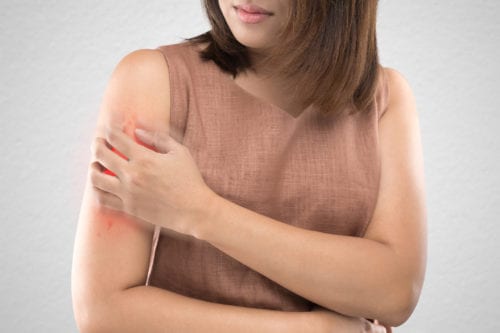
What is Bullous Pemphigoid?
Bullous pemphigoid is a type of autoimmune blistering disorder that causes cluster shaped blisters to form on various areas of the epidermis. There are three types of pemphigoids, with bullous as the most common. In areas where a lot of movement occurs, these lesions form quickly and turn to uncomfortable blisters. The groin and joint areas are particularly vulnerable as they are prone to irritation and chafing already.
Bullous Pemphigoid needs to be treated or else it can become debilitating and in some cases, life-threatening. Typically, this blistering disease affects patients over 60 but can appear in those younger as well. Bullous pemphigoid occurs when antibodies attach to hemidesmosomal antigens and cause a subepidermal boil, usually greater than or equal to 10mm in diameter.
Where does bullous pemphigoid come from?
In short, the inciting incident that triggers bullous pemphigoid is still relatively unknown. Dermatologists and medical researchers do know that it is an autoimmune disorder and that some medications can trigger its appearance, but the actual cause of the autoimmune disorder is unknown.
Most typically, bullous pemphigoid, or BP, occurs when the body’s own defense system turns on itself and attacks. The reason for this attack is still not known. In Bullous Pemphigoid, these autoantibodies go after a protein in the skin that binds the dermis and epidermis together. The separation of these two layers forms the visible blisters.
Demographics Most Affected by Bullous Pemphigoid
This blistering disorder affects both males and females but does seem to target the elderly specifically. The average age of a BP sufferer is 80 years old but some cases have been reported in young children and infants. Additionally, over one-third of people with bullous pemphigoid already have a neurological disorder like Parkinson’s, dementia, multiple sclerosis, and the like.
Risks and Symptoms
Even though many autoimmune blistering diseases can go away on their own, some can turn into life-threatening situations. Others don’t go away on their own and can linger, causing repeated rashes, blisters, and lesions.
When is Bullous Pemphigoid life-threatening?
The blisters themselves are not life-threatening, however, when the blisters burst and turn into lesions, they erode the epidermis’s protective barrier, making the patient vulnerable to infection. Fatal cases of Bullous Pemphigoid have resulted in the individual succumbing to sepsis. Since BP often afflicts the elderly populations, people that have BP often have a combination of other ailments or chronic illnesses.
Symptoms of Bullous Pemphigoid
Initially, symptoms may include redness and itchiness of the skin, especially in places where the dermis folds. The itchiness is often followed by urticaria hives. Other more obvious symptoms can take weeks to months to appear but when they do, bullous pemphigoid blisters are the telltale sign. The main symptoms of bullous pemphigoid are visible, large blisters that appear in cluster formations on various areas of the epidermis.
These blisters are particularly uncomfortable and appear in hive-like welts, called bullae. They frequently occur on arms, legs, stomach, groin, and in the mouth and can be somewhat transparent. Sometimes the blisters break open and become a gaping wound or an ulcer that doesn’t heal easily.
Treatment Options and Long Term Effects
Treatments available for bullous pemphigoid
The initial approach to treating BP is to alleviate discomfort, including itching and pain, from the blisters. Skincare ointment, bandages, and anti-itch creams can be used to relieve the irritation and prevent infections.
For those with large swaths of lesions, a doctor may prescribe a corticosteroid cream. However, in elderly patients or those with neurological disorders, the application of topical cream can be tricky. In that case, oral antibiotics and corticosteroids, like prednisone, can be an effective form of treatment.
In severe cases, doctors may choose to treat the autoimmune disorder with immunosuppressive drugs or anti-inflammatory antibiotics, like doxycycline. Immunosuppressives like rituximab can suppress the immune system and force it to stop all activity, including attacking its own proteins. For patients with already compromised immune systems, this treatment plan can be risky.
How long one can expect to have bullous pemphigoid before it is alleviated?
This blistering disorder can resolve itself on its own or may take many years to go away, even with medical intervention. There is no rhyme or reason for bullous pemphigoid and still much is unknown about autoimmune diseases. Symptoms, like itching, redness, and blistering, can be relieved quickly but bullae clusters have been known to crop up out of nowhere.
Scarring is a definite long-term effect of this dermal condition as well as mental health strain. Since BP is patient-specific, unpredictable, and sometimes unresponsive to treatment, patients afflicted with this skin disease can suffer tremendously under the stress and anxiety around being ill with a chronic condition. Even when all signs of bullous pemphigoid have retreated, the autoimmune blistering disease can reemerge randomly.
Be Proactive and Take Action
No matter the severity of your autoimmune blistering disease, you should consult with a doctor immediately. The sooner you and your health care provider come up with a comprehensive treatment plan, the better equipped you both are to monitor and manage any changes.
The Dermatological team at UCF Health focuses on the health and wellness of our body’s largest organ – the epidermis. Skilled dermatologists collaborate with our team of knowledgeable health care providers to diagnose, treat, and monitor chronic conditions such as autoimmune disorders.
Recognizing bullous pemphigoid early may help prevent you from its long term effects like recurrence, scarring, and sepsis. Itchy, painful lesions on the dermis certainly impact everyday life but identifying this skin disorder early can help quell the worst of it.
Visit our patient portal to learn about autoimmune conditions, meet our Orlando dermatologists, like Dr. Naveed Sami, and to get COVID updates for patients. Plus, our online appointment book makes it easy to schedule an appointment online. We look forward to helping you achieve all of your health and wellness goals.
